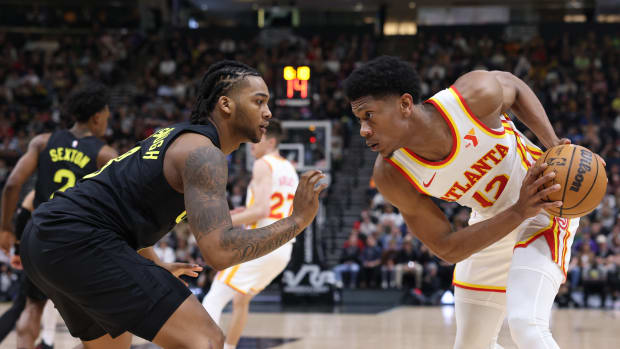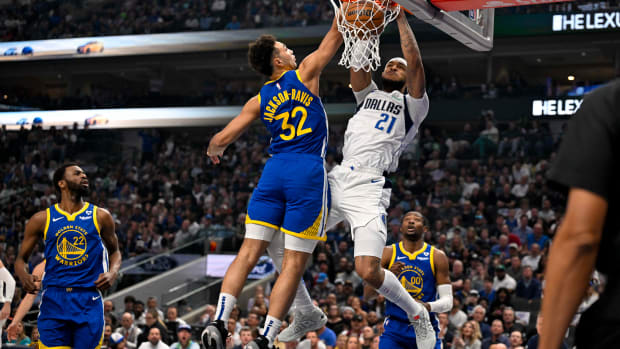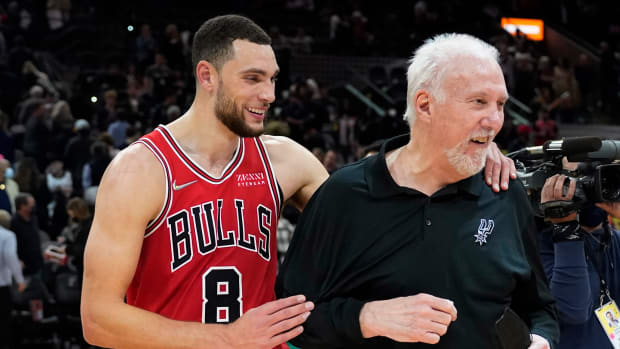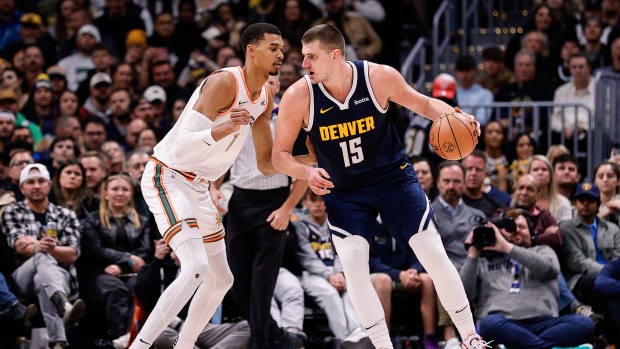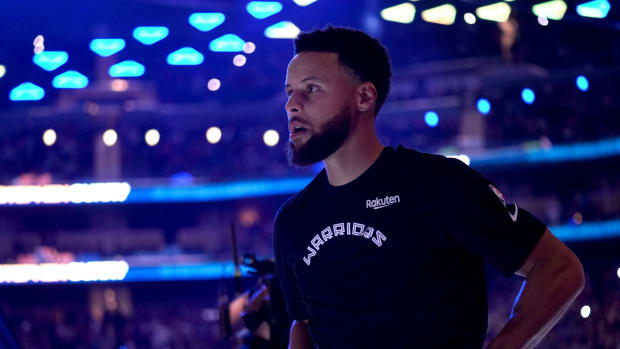Nike Countersues Kawhi Leonard in Ongoing Battle Over 'The Klaw' Logo
Take a look at these artistic renditions of two logos:
How similar are they?
Both are of hands. But the one on the left is an outline of a hand whereas the one on the right focuses more on the fingers.
Both refer to “KL.” But the one on the left does so with a marker while the one on the right does so through the placement of the fingers.
Both refer to “2.” But the designs of this number vary.
The degree to which these two logos are similar and dissimilar lies at the heart of a widening and complex legal dispute between Los Angeles Clippers star Kawhi Leonard and Nike. Leonard endorsed Nike from 2011 to 2018 but turned down an offer to remain with the company into the 2020s.
Both sides claim intellectual property ownership in a logo that is popularly called “the Klaw” or “KL2." Both are suing each other in federal court over those competing conclusions.
Leonard sues first
Last month, Leonard sued Nike in the U.S. District Court for the Southern District of California. The lawsuit was analyzed in a Sports Illustrated legal story. The short of it: Leonard seeks a declaration from U.S. District Judge Cynthia Bashant that (1) he is the “sole author” of the Klaw logo; (2) he has not infringed on any rights of Nike; and (3) Nike committed fraud by registering the logo with the U.S. Copyright Office in Washington, D.C.
Leonard’s legal team includes Sullivan and Worcester’s Peter Ginsburg, who has litigated on behalf of Jonathan Vilma, Ray Rice, Vijay Singh and other pro athletes, and Scott Metzger of San Diego’s Duckor, Spradling, Metzger & Wynne.
Leonard’s complaint refers to the logo as the “Leonard Logo," the original idea for which he says came to him while he starred for San Diego State from 2009 to 2011. This logo emphasizes Leonard’s relatively large hands, which have helped him become one of the best defensive players in basketball, as well as his jersey number.
While Leonard was a rookie on the San Antonio Spurs in December 2011, he used his logo concept to design a more refined version. He shared this design with friends, advisors and Nike, who had signed Leonard to an endorsement deal a few months earlier. Leonard’s complaint stresses that he rejected several variations of the logo that Nike designers had hatched. He urged the designers to generally stick to his logo idea. Leonard further insists that the logo remained under his control while he was associated to Nike. Last November, he received a trademark registration for the logo from the U.S. Patent and Trademark office.
Nike strikes back in court
On Wednesday, Nike went on offense. The apparel company answered Leonard’s complaint and countersued him for copyright infringement, breach of contract and fraud. Nike asserts that Leonard is unlawfully conflating two separate and distinct logos and wrongfully claiming ownership. It seeks dismissal of Leonard’s lawsuit, a declaration that Nike owns the copyright in the logo and an injunction to stop Leonard from using the logo going forward.
Nike is represented by three accomplished intellectual property attorneys from the law firm DLA Piper: Stanley Panikowski, a former clerk to (now-retired) U.S. Supreme Court Justice Sandra Day O’Connor and an attorney for the NFL in connection to the league seizing counterfeit merchandise at Super Bowl XXXVII; Tamar Duvdevani, who has represented Nike in trademark infringement litigation and who serves as the New York chair of her firm’s Intellectual Property and Technology group; and Matthew Ganas, a sports attorney who has worked on litigation involving teams in Serie A, the WNBA and other leagues.
Nike doesn’t contest Leonard’s ownership in the “rough draft” (depicted above on the left). It also doesn’t dispute that Leonard shared his logo concept with company officials. The company instead stresses that Nike’s designers engineered a separate logo (depicted above on the right) and that the Nike logo is appreciably different from—and more marketable than—Leonard’s design. The logo in which Nike claims ownership has been used in various products, including the Air Jordan 6 The Claw.
New Balance and the Clippers have stakes in the litigation
Leonard and Nike aren’t the only interested parties in their logo dispute. New Balance, which inked Leonard to a multi-year endorsement deal last November, would like the ability to market Leonard without any restrictions stemming from Leonard’s past dealings with Nike. It thus has an interest in Leonard obtaining a favorable result. The same is true of other companies with whom Leonard has signed endorsements. One recently reported addition to Leonard’s endorsement list is Cargo Jet Airways.
To that point, companies in contract with Leonard recognize that he has become one of the NBA’s most dominant and marketable players. The 28-year-old Los Angeles native received the Bill Russell NBA Finals MVP Award last month when he led the Toronto Raptors to the franchise’s first-ever title. Leonard is also the first player in NBA history to win the Russell Award in both the Eastern Conference and Western Conference (he also won it in 2014 for the Spurs).
The intense interest in Leonard’s recent free agency saga illustrates the degree to which he has become a megastar. His new Clippers coach, Doc Rivers, played against Michael Jordan back in the '80s and '90s. Rivers has gone so far as to say that Leonard is the “most like Jordan we’ve seen.” High praise indeed and reflective of Leonard’s stardom.
Speaking of the Clippers, the team (per Marc Stein of The New York Times) previously explored the possibility of purchasing rights to the logo. While the team’s interest in the logo may have been motivated mainly as a means to recruit Leonard as a free agent, the team might eye other purposes as well. If so, the Clippers will be carefully monitoring the litigation.
Importance of language in the endorsement deal signed by Leonard and Nike
Leonard and Nike clearly disagree about the impact of the contract they signed in 2011 (and subsequently extended) on their ongoing legal battle.
From Leonard’s perspective, the contract did not compel him to convey any intellectual property in his logo design. Along those lines, Leonard and his attorneys reject Nike’s depiction of the Klaw logo in the company’s registration with the U.S. Copyright Office as a “work for hire.” Such an expression refers to when an employer claims it owns the intellectual property creations of a worker or contracted entity. Leonard insists that the design originates in his imagination long before he ever struck a deal with Nike.
Nike views the topic differently. The company insists that the contract makes Nike the owner of the logo. Nike’s court filings include a heavily redacted copy of the contract as an exhibit. As an overarching point, the contract contemplates Leonard providing “personal services and expertise in the sport of professional basketball and endorsement of the Nike brand and use of Nike products.”
The contract notes that Nike contracted not with Leonard but with Leonard’s limited liability company, Kawhi Leonard, LLC. As I explained in a Sports Illustrated story on Derrick Rose and Adidas, it is not uncommon for a player to form an LLC for purposes of signing endorsement deals. The player generally takes on less financial and legal risk by using an LLC, which is a separate entity. Here, the Nike contract makes clear that Leonard is “under an exclusive employment agreement” with his own LLC.
Under the contract’s standard terms and conditions is a clause concerning ownership of any designs:
OWNERSHIP OF NIKE MARKS, DESIGNS & CREATIVES
CONSULTANT [Kawhi Leonard LLC] (a) acknowledges that NIKE exclusively owns all rights, title and interest in and to the NIKE Marks and that NIKE shall exclusively own all rights, title and interest in and to any logos, trademarks, service marks, characters, personas, copyrights, shoe or other product designs, patents, trade secrets or other forms of intellectual property created by NIKE (and/or its agents), CONSULTANT or ATHLETE in connection with this Contract . . . (c) further acknowledges that after expiration or termination of this Contract, NIKE shall continue to have the unrestricted right to use (and without any CONSULTANT or ATHLETE approval) such intellectual property . . . provided that such post-contractual use shall not then include the ATHLETE Endorsement.
Nike reads this language to mean that the company owns any intellectual property created during the life of the contract. Leonard, presumably, will argue that his design was not “in connection to this contract” but rather hatched on his own time. Ideally for Leonard, he would have drawn this idea on paper, or sketched it on his computer, before his Nike contract began. Copyright protection begins the moment a work is created in tangible form. However, if an idea doesn’t go from someone’s mind to pen to paper (or to computer or recording, etc.), and instead stays as a thought, it won’t gain protection.
Nike seems to anticipate this type of rebuttal by stressing that the contract contains what is often called a “merger clause” or an “integration clause.” Such a clause stipulates that the contract reflects the entire relationship between the parties. The Leonard-Nike contract contains such a clause and it expresses the following:
This Contract shall constitute the entire understanding between CONSULTANT and NIKE and may not be altered or modified except by a written agreement, signed by both parties. Any previous agreements between the parties shall have no further force or effect.
Nike thus maintains that Leonard can’t expect to possess legal rights in the logo outside of those rights explicitly stated in the contract.
Nike uses Leonard’s own words against him
Back in 2014, Leonard and Nike were on good terms. There was no expectation that their endorsement relationship would end. With that context in mind and looking back through the unfair lens of hindsight, Leonard made a series of ill-advised comments to the publication Nice Kicks about his relationship with Nike.
Nice Kicks is a publication mainly for shoe- and sneaker-enthusiasts. Nike’s complaint repeatedly quotes Leonard’s remarks in the Nice Kicks story titled, The Oral History of Kawhi Leonard’s “Klaw” Logo. This story was originally published on October 29, 2014, and is credited to George Kiel and Sid Ashford.
In the story, Leonard is quoted as saying:
I came up with the idea of incorporating my initials in this logo. I drew up the rough draft, sent it over and they (Jordan Brand) made it perfect. I give the Jordan Brand team all the credit because I’m no artist at all. They refined it and made it look better than I thought it would ever be, and I’m extremely happy with the final version.
I’m sure Leonard wishes he never gave that interview. But what’s done is done.
Nike clearly remembered the interview. The company stresses that, in Leonard’s own words, he admits he did not author the logo that was commercially used by Nike and contemplated in Nike’s copyright registration. Leonard, who in the story also confesses that he is “no artist at all,” also praises Nike’s designers, giving them “all the credit.”
That said, the quoted language does provide some wiggle room for Leonard. He could insist that his remarks are consistent with him being the logo’s creator. Notice in the quote that he claims it was his idea to incorporate his initials in the logo and that he drafted the logo, at least its first version.
Leonard further stresses that Nike “refined” and improved the logo. This is consistent with an argument that Nike’s modifications were based on his creation and that he maintained a contractual right to approve any modifications. Leonard could thus insist that while Nike may own copyright protection for the refinements made to “his” logo under a theory that the refined logo is a derivative work, the original work itself has remained under his ownership the whole time. If that reasoning is correct, Leonard would enjoy a right to use certain versions of the logo and license them.
This case will likely end in a settlement
While the dueling complaints suggest that Leonard and Nike are engaged in an acrimonious legal battle, chances are both sides will peacefully negotiate a solution out-of-court.
Take Leonard’s goals. He presumably wants New Balance and other sponsored companies to be able to use the Klaw logo without worrying about Nike suing them. Leonard also likely wants to focus his energies not on logo litigation or on speaking with attorneys, but on leading the Clippers.
Now consider Nike’s perspective. The company’s relationship with Leonard is most decidedly over. Further, as time goes on, consumers will increasingly associate Leonard with the New Balance brand. This means whatever Nike might hope to gain from some sort of perceived association with Leonard will only dissipate.
Nike also needs to be careful in how aggressively it challenges Leonard in court. Other NBA stars might become less inclined to do business with Nike if the company is perceived as treating its former players poorly, especially a player as influential as Leonard. Given that NBA stars now have several options for sneaker deals—including Nike, Adidas, New Balance, Under Armour and Puma—Nike’s control over this market is not quite as dominant as it once was.
With those points in mind, Leonard and Nike will probably negotiate a financial settlement to end their lawsuit. A logical arrangement would be one where Leonard agrees to pay Nike a fee or a portion of royalties going forward. Nike, meanwhile, would agree to drop any claims.
Still, a settlement could take a while to happen. In addition to countersuing Leonard, Nike has filed a motion to transfer the case to the U.S. District Court for Oregon—which is, obviously, located in the state of Nike’s headquarters. Nike emphasizes that the contract contains a choice-of-law and forum-selection provision. This provision indicates that any lawsuit or action arising out of the contract is governed by Oregon law and must be litigated in Oregon.
Leonard will likely oppose the prospective transfer by arguing that part of the case concerns what happened while he was a student at San Diego State and thus before he entered into a contract with Nike. No matter how the motion plays out, it will probably elongate the timeline.
We’ll keep you posted on key developments.
Michael McCann is SI’s Legal Analyst. He is also an attorney and Founding Director of the Sports and Entertainment Law Institute at UNH Franklin Pierce School of Law.































